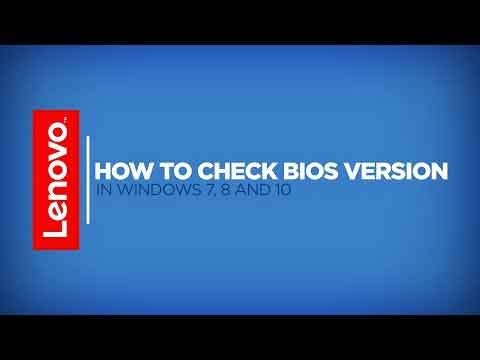Loading…
How To Check BIOS Version | A Review of The Quick and Easy Methods
The how to check BIOS version article is a supplementary page for the successful American Megatrends BIOS Update article.
I receive many questions from visitors about how to find out what the BIOS or UEFI make and version are on their devices. This is an important step because you simply cannot update your firmware yourself unless you have this critical piece of information.
Often we are unable to note the BIOS or UEFI details when devices are booting. This is because the information flashes up on screen and disappears before you have a chance to register the information. This is a source of frustration.
In addition, some visitors are not keen on downloading and installing third-party tools and utilities to help identify their device's BIOS details. This is understandable considering the proliferation of malware on the Internet these days.
Therefore, this article focuses on the alternative methods of identifying your BIOS version, focusing specifically on the Windows operating system, This is because it is still the most popular O/S in the world by some margin.
Join The Human Byte — get the free BIOS Update A-to-Z guide
- Follow a safe, step-by-step BIOS update process
- Printable checklist + pitfalls to avoid
- Monthly email with practical PC tips.
- I only use your e-mail for the newsletter. Unsubscribe anytime.
Contents
Windows Operating System
MSINFO32 Command and System Information
With modern Microsoft Windows operating systems, from at least Windows 7 and above, it is often straightforward to find the make and version of your devices' Firmware and Motherboard.
This method does not require a system reboot, or any prerequisite changes to pause the boot process, or anything equally complicated, and can be done in three easy steps.
1. Load the Run Command Window by selecting Start > Run, or select the Windows Key + R key. Enter "msinfo32" (without quotations) the click OK.
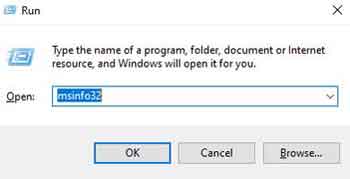 How To Check BIOS Version
How To Check BIOS VersionWindows O/S Run Command Window
2. Under System Summary, I have highlighted the information we are interested in. The first details are your computer's BIOS Version/Date. In my case, it is the Lenovo 8VCN27WW, which was released on the 22nd September.
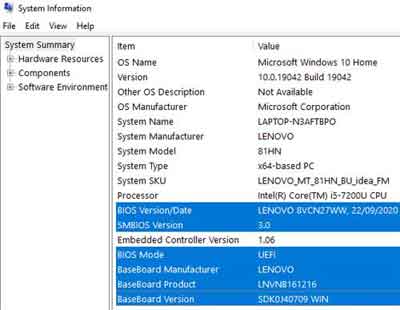 How To Check BIOS Version
How To Check BIOS VersionWindows Operating System MSINFO32 Command
System Information
SMBIOS, or System Management BIOS, is the method used to enable information such as your BIOS version and Motherboard Product to be understood (by Operating Systems in this instance). My Laptop is running version 3, which enabled 64-bit technology to be interpreted.
The BIOS mode determines whether your devices is running the modern UEFI version of firmware, or the Legacy version, which is the traditional BIOS we all know and love.
3. The next set of information is the three Baseboard entries. This is your device's Motherboard details, which is important when determining which manufacturer's firmware program you should be applying to your device.
As you can see, my Laptop's Motherboard is the Lenovo LNVNB161216, version SDK0J40709 WIN. It is this information I would use to search the Lenovo website for the latest update packages.
If the package is a later version than what I currently have installed on my Laptop, I will consider updating with this latest version.
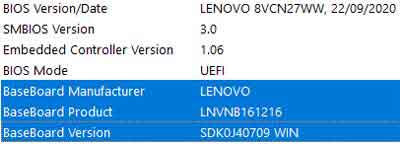 How To Check BIOS Version
How To Check BIOS VersionIdentifying Your Devices Motherboard Details
To keep a record of your System Information, or to review offline at a later date, for example, you can export the information to a text file, which you can then format at your leisure.
To do this, simply click File > Export, then give the file a name and a location to be downloaded to.
If you are a big user of the Command Prompt, you can also display your devices' System Information here by selecting the Windows Key + R Key, then entering "CMD" (without the quotations), and clicking OK. From here type "systeminfo" (without the quotations) and hit return.
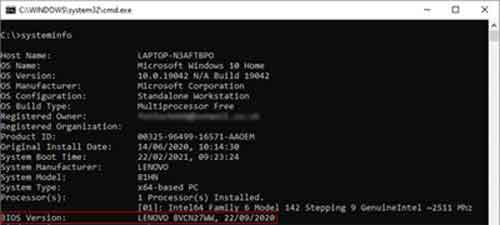 How To Check BIOS Version
How To Check BIOS VersionSysteminfo By Command Prompt
Occasionally, the firmware version is not displayed in System Information. This is where you can try other methods below, or consider taking the plunge and using a downloadable utility.
Return to the Table of Contents
Command Prompt Instructions
Carrying on the theme from the end of the previous section, there are command prompt instructions that will also display your firmware details, and I'll explain one of these commands below.
1. Load the Run Command Window by selecting Start > Run, or select the Windows Key + R key. Enter "cmd" (without quotations) the click OK to load the Windows Command Prompt.
2. From here, simply type the following commands and hit the return key:-
- wmic bios get smbiosbiosversion
- wmic bios get biosversion
Each command displays the following information in the image below. This information correlates with what was provided by the System Information window.
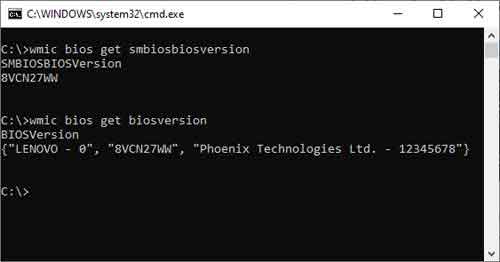 How To Check BIOS Version
How To Check BIOS VersionIdentify Your Device's BIOS Version From The Command Prompt
To save some time typing out long commands, copy the command text above, then left-click, or tap, the Command Prompt "Fav Icon" at the top-left of the Command Prompt Window. From here, select Edit from the menu, then Paste.
Alternatively, use the shortcut Ctrl + V to paste the command directly in to the Command Prompt.
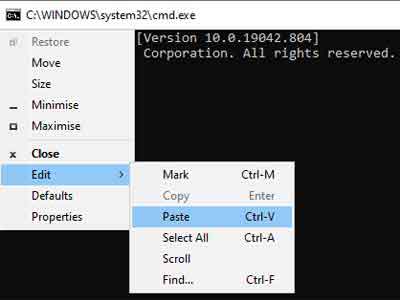 How To Check BIOS Version
How To Check BIOS VersionPasting Commands Into The Windows Command Prompt
There are more command prompt instructions available that will display more information about your device's firmware.
However, I think the commands above are more than enough for you to sufficiently identify the necessary information to go and find the right website and appropriate update package for your computer.
The short video below underpins the instructions above with a demonstration of the Command Prompt instruction.
How To Check BIOS Version Video
Return to the Table of Contents
The Registry Is A Last Resort
I was hesitant to include this method as a means of identifying your computer's BIOS because the Registry should be avoided at all costs if you do not know what you are doing.
However, on the other hand, the article would not be complete without covering this option. We are not changing anything. We are simply to search, and so long as stick to the steps below, no damage should occur.
1. Load the Run Command Window by selecting Start > Run, or select the Windows Key + R key. Enter "regedit" (without quotations) the click OK to load the Registry Editor.
2. Using the Registry Hive structure in the left-hand windowpane, drill down to the location below, then check out the SystemBiosVersion Multi String Value in the right-hand windowpane:-
- HKEY_LOCAL_MACHINE > HARDWARE > Description > System
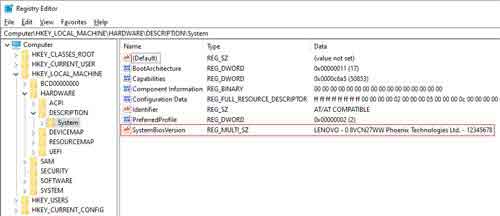 How To Check BIOS Version
How To Check BIOS VersionRegistry Editor BIOS Details
If you need further information, including details of your Motherboard, drill down to the following Hive location:-
- HKEY_LOCAL_MACHINE > HARDWARE > Description > System > BIOS
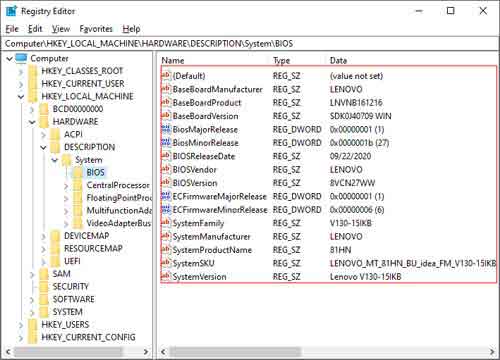 How To Check BIOS Version
How To Check BIOS VersionRegistry Editor Additional BIOS Details
Return to the Table of Contents
How to Check BIOS Version | Final Thoughts
The how to check BIOS version article details the three main methods of identifying your devices firmware details without the need for downloading utilities or 3rd-party products such as those provided by CPUID, such as the CPU-Z tool.
In addition, when it comes to searching for the firmware packages of the those, more obscure, motherboard makes and models, take a look at how to search the internet for lots of advice on how to pinpoint your search criteria.
I'll leave you with some excellent references that cover additional methods and steps for identifying and updating your device's firmware versions.
They include the how to check your BIOS version and update it article, the how to find BIOS version on a computer article, from Online Tech Tips, and the how to find the BIOS version and Check if it is Up-to-Date article, from Windows Help Online.
